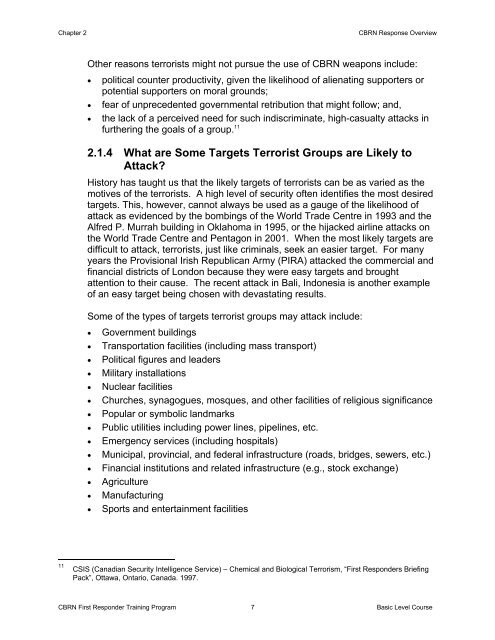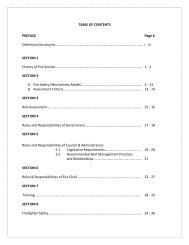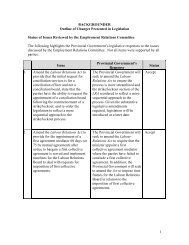Basic Level Pre-Course Reading
Basic Level Pre-Course Reading
Basic Level Pre-Course Reading
You also want an ePaper? Increase the reach of your titles
YUMPU automatically turns print PDFs into web optimized ePapers that Google loves.
Chapter 2<br />
CBRN Response Overview<br />
Other reasons terrorists might not pursue the use of CBRN weapons include:<br />
• political counter productivity, given the likelihood of alienating supporters or<br />
potential supporters on moral grounds;<br />
• fear of unprecedented governmental retribution that might follow; and,<br />
• the lack of a perceived need for such indiscriminate, high-casualty attacks in<br />
furthering the goals of a group. 11<br />
2.1.4 What are Some Targets Terrorist Groups are Likely to<br />
Attack?<br />
History has taught us that the likely targets of terrorists can be as varied as the<br />
motives of the terrorists. A high level of security often identifies the most desired<br />
targets. This, however, cannot always be used as a gauge of the likelihood of<br />
attack as evidenced by the bombings of the World Trade Centre in 1993 and the<br />
Alfred P. Murrah building in Oklahoma in 1995, or the hijacked airline attacks on<br />
the World Trade Centre and Pentagon in 2001. When the most likely targets are<br />
difficult to attack, terrorists, just like criminals, seek an easier target. For many<br />
years the Provisional Irish Republican Army (PIRA) attacked the commercial and<br />
financial districts of London because they were easy targets and brought<br />
attention to their cause. The recent attack in Bali, Indonesia is another example<br />
of an easy target being chosen with devastating results.<br />
Some of the types of targets terrorist groups may attack include:<br />
• Government buildings<br />
• Transportation facilities (including mass transport)<br />
• Political figures and leaders<br />
• Military installations<br />
• Nuclear facilities<br />
• Churches, synagogues, mosques, and other facilities of religious significance<br />
• Popular or symbolic landmarks<br />
• Public utilities including power lines, pipelines, etc.<br />
• Emergency services (including hospitals)<br />
• Municipal, provincial, and federal infrastructure (roads, bridges, sewers, etc.)<br />
• Financial institutions and related infrastructure (e.g., stock exchange)<br />
• Agriculture<br />
• Manufacturing<br />
• Sports and entertainment facilities<br />
11<br />
CSIS (Canadian Security Intelligence Service) – Chemical and Biological Terrorism, “First Responders Briefing<br />
Pack”, Ottawa, Ontario, Canada. 1997.<br />
CBRN First Responder Training Program 7 <strong>Basic</strong> <strong>Level</strong> <strong>Course</strong>

















